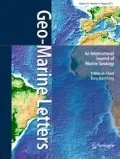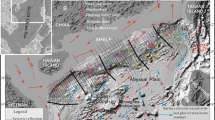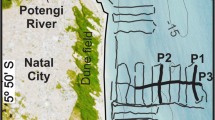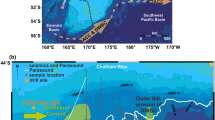Abstract
The Gaoping River-Gaoping Submarine Canyon (GPC) is one of the dispersal river systems in the world. Tens of tons of terrestrial sediments discharge per year at the mouth of the river, where gravity-driven flow can damage the telecommunication cable along the 260-km-long GPC; to the east of the GPC, the continental shelf has been eroded. To understand this geological phenomenon, high-resolution sparker seismic data around the continental shelf as well as parallel and across the GPC were collected. Deep-towed sub-bottom profiler (SBP) data and data from shipboard acoustic Doppler current profiler were also collected. Three major system tracts off southwest Taiwan were identified, based on which the coastline of the last glacial maximum was identified at approximately 138 m below the current sea level. Analysis of the deep-towed SBP profiles suggested sandy sediment overflows through breakages on the east bank of the GPC. A convergence of bottom currents with a speed of up to 1.5 m/s flowing southeastward has eroded the continental shelf intensively, forming the Xiaoliuchiu channel. Although a mud diapir is active to the east of the GPC and forms the Xiaoliuchiu islet, it has been eroded at the Xiaoliuchiu channel. The average erosion rate on the east bank of the GPC was estimated to be approximately 609 cm/ka in the past 8.2 ka; between the GPC and the Xiaoliuchiu islet, the continental shelf is wasted due to severe seabed slumping.







Similar content being viewed by others
References
Carter L, Milliman JD, Talling PJ, Gavey R, Wynn RB (2012) Near synchronous and delayed initiation of long run-out submarine sediment flows from a record-breaking river flood, offshore Taiwan. Geophy Res Lett 39:L12603. https://doi.org/10.1029/2012GL051172
Chen SC, Hsu SK, Wang Y, Chung SH, Chen PC, Tsai CH, Liu CS, Lin HS, Lee YW (2014) Distribution and characters of the mud diapirs and mud volcanoes off southwest Taiwan. J Asian Ear Sci 92:201–214. https://doi.org/10.1016/j.jseaes.2013.10.009
Chen SC, Tsai CH, Hsu SK, Yeh YC, Liu CS, Chung SH, Wei CY (2018) Fangliao Slide—a large slope failure in the upper Kaoping Slope off southwest Taiwan. Terr Atmos Ocean Sci 29:17–30. https://doi.org/10.3319/TAO.2017.06.14.01
Chen H, Zhang W, Xie X, Ren J (2019) Sediment dynamics driven by contour currents and mesoscale eddies along continental slope: a case study of the northern South China Sea. Mar Geol 409:48–66. https://doi.org/10.1016/j.margeo.2018.12.012
Chiang CS, Yu HS (2006) Morphotectonics and incision of the Kaoping submarine canyon, SW Taiwan orogenic wedge. Geomorphology 80(3-4):199–213. https://doi.org/10.1016/j.geomorph.2006.02.008
Chiang CS, Yu HS (2008) Evidence of hyperpycnal flows at the head of the meandering Kaoping Canyon off SW Taiwan. Geo-Marine Letters 28(3):161–169. https://doi.org/10.1007/s00367-007-0098-7
Chiang CS, Yu HS (2011) Sedimentary erosive processes and sediment dispersal in Kaoping submarine canyon. Science China Earth Sciences 54(2):259–271. https://doi.org/10.1007/s11430-010-4076-y
Chiang CS, Hsiung KH, Yu YS, Chen SC (2020) Three types of modern submarine canyons on the tectonically active continental margin offshore southwestern Taiwan. Mar Geophy Res 41(4). https://doi.org/10.1007/s11001-020-09403-z
Dadson SJ, Hovius N, Chen H, Dade WB, Hsieh ML, Willett SD, Hu JC, Horng MJ, Chen MC, Star CP, Lague D, Lin JC (2003) Links between erosion, runoff variability and seismicity in the Taiwan orogeny. Nature 426:648–651. https://doi.org/10.1038/nature02150
Gasser M, Pelegri JL, Emelianov M, Bruno M, Gracia EG, Pastor M, Peters H, Rodriguez-Santana A, Salvador J, Sanchez-Leal RF (2017) Tracking the Mediterranean outflow in the Gulf of Cadiz. Prog In Ocean 157:47–71. https://doi.org/10.1016/j.pocean.2017.05.015
Harris PT, Whiteway T (2011) Global distribution of large submarine canyons: Geomorphic differences between active and passive continental margins. Marine Geology 285:69–86. https://doi.org/10.1016/j.margeo.2011.05.008
Hernandez-Molina FJ, Liave E, Stow DAV (2008) Chapter 19 Continental Slope Contourites. Developments in Sedimentology 60:379–408. https://doi.org/10.1016/S0070-4571(08)10019-X
Hjulstrom F (1935) Studies of morphological activity of rivers as illustrated by the River Fyris. Bulletin of the Geological Institute University of Uppsala 25:221–227
Hsiung KH, Yu HS, Chiang CS (2018) The modern Kaoping transient fan offshore SW Taiwan: morphotectonics and development. Geomorphology 300:151–163. https://doi.org/10.1016/j.geomorph.2017.10.013
Hsu SK, Kao J, Lo CL, Tsai CH, Doo WB, Ku CY, Sibuet JC (2008) Turbidity currents, submarine landslides and the 2006 Pingtung Earthquake off SW Taiwan. Terr Atmos Ocean Sci 19(6):767–772. https://doi.org/10.3319/TAO.2008.19.6.767(PT)
Hsu SK, Lin SH, Wang SY, Tsai CH, Doo WB, Chen CS, Lin JY, Yeh YC, Wang HF, Su CW (2018) Seabed gas emissions and submarine land- slides off SW Taiwan. Terr Atmos Ocean Sci 29:7–15. https://doi.org/10.3319/TAO.2016.10.04.01
Jan S, Wang J, Chern C-S, Chao S-Y (2002) Seasonal variation of the circulation in the Taiwan Strait. J Mar Sys 35:249–268. https://doi.org/10.1016/S0924-7963(02)00130-6
Jan S, Tseng YH, Dietrich DE (2010) Sources of water in the Taiwan Strait. J Ocean 66:211–221. https://doi.org/10.1007/s10872-010-0019-7
Jan S, Wang SH, Yang KC, Yang YJ, Chang MH (2019) Glider observations of interleaving layers beneath the Kuroshio primary velocity core east of Taiwan and analyses of underlying dynamics. Sci Rep 9:11401. https://doi.org/10.1038/s41598-019-47912-z
Lacombe O, Angelier J, Mouthereau F, Chu HT, Deffontaines B, Lee JC, Rocher M, Chen RF, Siame L (2004) The Liuchiu Hsu island offshore SW Taiwan: tectonic versus diapiric anticline development and comparisons with onshore structures. Comptes Rendus Geoscience 336:815–825. https://doi.org/10.1016/j.crte.2004.02.007
Lambeck K, Rouby H, Purcell A, Sun Y, Sambridge M (2014) Sea level and global ice volumes from the Last Glacial Maximum to the Holocene. PNAS 111:43: 15296–L. https://doi.org/10.1073/pnas.1411762111
Le Bot P, Kermabon C, Lherminier P, Gaillard F (2011) CASCADE V6.1: Logiciel de validation et de visualisation des measures ADCP de coque. Rapport technique OPS/LPO 11-01, IFREMER, Centre de Brest, France.
Levchenko OV, Roslyakov AG (2010) Cyclic sediment waves on western slope of the Caspian Sea as possible indicators of main transgressive/regressive events. Quaternary International 225:210–220. https://doi.org/10.1016/j.quaint.2009.12.001
Liu CS, Huang IL, Teng LS (1997) Structural features off southwestern Taiwan. Mar Geol 137:305–319. https://doi.org/10.1016/S0025-3227(96)00093-X
Liu CS, Liu SY, Lallemand SE, Lundberg N, Reed D (1998) Digital elevation model offshore Taiwan and its tectonic implications. Terr Atmo Oceans Sci 9(4): 705–738. 10.0.12.247/TAO.1998.9.4.705(TAICRUST)
Liu JT, Hsu RT, Hung JJ, Kao SJ, Chang YP, Huh CA, Wang YH, Lee CL, Yang RJ (2016) From the highest to the deepest: the Gaoping River-Gaoping Submarine Canyon dispersal system. Earth-Science Reviews 153:274–300. https://doi.org/10.1016/j.earscirev.2015.10.012
Mitchum RM, Vali PR, Sangree JB (1977) Seismic stratigraphy and glocal changes of sea level: Part 6: Stratigraphic interpretation of seismic reflection patterns in depositional sequences: Section 2. Application of seismic reflection configuration to stratigraphic interpretation in C. E. Payton, ed. Seismic stratigraphy- applications to hydrocarbon exploration: AAPG Memoir 26:117–133. https://doi.org/10.1306/M26490C8
Nan F, Xue H, Yu F (2015) Kuroshio intrusion into the South China Sea: a review. Progress in Oceanography 137:314–333. https://doi.org/10.1016/j.pocean.2014.05.012
Stockwell JW, Cohen JK (2002) The mew SU user’s manual. Golden: CWP, Colorado School of Mines. https://doi.org/10.1007/BFb0012094
Stow D, Smillie Z, Esentia IP (2018) Deep-sea bottom current: their nature and distribution. In Encyclopedia of ocean sciences: earth systems and environmental sciences (3 ed.).
Su CC, Hsu ST, Hsu HH, Lin JY, Dong JJ (2018) Sedimentological characteristics and seafloor failure offshore SW Taiwan. Terr Atmos Ocean Sci 29(1):65–76. https://doi.org/10.3319/TAO.2017.06.21.01
Sun CC, Liu CS (1993) Mud dipir and submarine channel deposits in offshore Kaohsiung-Hengchun, southwest Taiwan. Petroleum Geology of Taiwan 28:1–14
Vail PR, Mitchum Jr RM, Thompson III S (1977) Seismic stratigraphy and global changes of sea level: Part 3. Relative changes of sea level from costal onlap: Section 2. Application of seismic reflection configuration to stratigrapic interpretation In: Seismic stratigraphy—applications to hydrocarbon exploration, 1st edn. American Association of Petroleum Geologists, pp 63–81.
Van Wagoner JC, Posamentier H, Mitchum RM, Vail PR, Sarg JF, Loutit TS, Hardenbol J (1988) An overview of the fundamentals of sequence stratigraphy and key definitions. Soc. Econ. Paleontol Mineral Spec Publ 42:39–46
Van Wagoner JC, Mitchum JC, Campion K, Rahmanian V (1990) Siliciclastic sequence stratigraphy in well logs, cores, and outcrops: concepts for high-resolution correlation of time and facies. The American Association of Petroleum 7:55. https://doi.org/10.1306/Mth7510
Viana AR (2001) Seismic expression of shallow- to deep-water contourites along the south-eastern Brazilian margin. Mar Geophys Res 22:509–521. https://doi.org/10.1023/A:1016307918182
Viana AR, Faugères JC, Stow DAV (1998a) Bottom-current controlled sand deposits: a review from modern shallow to deep water environments. Sediment Geol 115:53–80. https://doi.org/10.1016/S0037-0738(97)00087-0
Viana AR, Faugeèes JC, Kowsman RO, Lima JAM, Caddah LFG, Rizzo JG (1998b) Hydrology, morphology and sedimentology of the Campos continental margin, offshore Brazil. Sediment Geol 115:133–158. https://doi.org/10.1016/S0037-0738(97)00090-0
Viana AR, De Almeida W, De Almeida CW (2002a) Upper slope sands: Late Quaternary shallow-water sandy contourites of Campos Basin, SW Atlantic margin. Geol Soc London Mem 22:261–270. https://doi.org/10.1144/GSL.MEM.2002.022.01.19
Viana AR, Hercos C, De Almeida W, Magelhaes JL, De Andrade SB (2002b) Evidence of bottom current influence on the Neogene to Quaternary sedimentation along the northern Campos slope, SW Atlantic margin. Geol Soc London Mem 22:249–260. https://doi.org/10.1144/GSL.MEM.2002.022.01.18
Wessel P, Smith WHF, Scharroo R, Luis JF, Wobbe F (2013) Generic mapping tools: improved version released. EOS Trans AGU 94:409–410. https://doi.org/10.1002/2013EO450001
Yang Q, Liu H, Lin P (2020) The effect of oceanic mesoscale eddies on the looping path of the Kuroshio intrusion in the Luzon Strait. Sci Rep 10:636. https://doi.org/10.1038/s41598-020-57487-9
Yu HS, Auster PJ, Cooper RA (1993) Surface geology and biology at the head of Kaoping canyon off southwestern Taiwan. Terr Atmos Ocean Sci 4(4):441–455
Yu HS, Chiang CS, Shen CM (2009) Tectonically active sediment dispersal system in SW Taiwan margin with emphasis on the Gaoping (Kaoping) Submarine Canyon. J Mar Syst 76(4):369–382. https://doi.org/10.3319/TAO.1993.4.4.441(O)
Yu SW, Tsai LL, Talling PJ, Lin AT, Mii HS, Chung SH, Horng CS (2017) Sea level and climatic controls on turbidite occurrence for the past 26 kyr on the bank of the Gaoping Canyon off SW Taiwan. Mar Geol 392:140–150. https://doi.org/10.1016/j.margeo.2017.08.011
Acknowledgments
We are grateful for the crew of R/V Ocean Research I (ORI-1179 and ORI-1180 cruises) and R/V Ocean Research III (ORIII-2019 cruise) for helping us to collect precious geophysical data. Special thanks belong to Mr. Shye-Dong Chiu and Mr. Hsin-Sung Hsieh for helpful discussions on deployment techniques during high-resolution marine geophysical surveys. Mr. Jay Li from the Department of Oceanography, National Sun-yat sen University, provided thoughtful comments on the dynamics of ocean currents. The constructive comments from Joonas Virtasalo and an anonymous reviewers helped to revise this paper that is appreciated very much.
Author information
Authors and Affiliations
Corresponding author
Additional information
Publisher’s note
Springer Nature remains neutral with regard to jurisdictional claims in published maps and institutional affiliations.
Supplementary information
To better understand how the surface KC affects the seafloor and its seasonal variation in the study area, the ship board ADCP current field was plotted for cross sections at two depths: 20 m below sea level and 36 m below sea level (Figs. S1 and S2). In Fig. S1, the KC flows trending in the NW–SE direction on the west bank of the GPC, with the current splitting into two branches and surrounding the Xiaoliuchiu islet. The northern branch rotates clockwise and accelerates up to 1.5 m/s close to the seafloor. The cross section at 36 m depth also exhibits a similar pattern. However, this clockwise rotation can affect the seafloor (Fig. 1b). This probably explains how the Xiaoliuchiu channel was formed, and why erosion is more focused on this channel. It is worth mentioning that the near- bottom current speed is still high in the Xiaoliuchiu channel during summer (Fig. S3). This indicates that continuous erosion by Kuroshio looping occurs in the Xiaoliuchiu channel.
Fig. S1
Ship board ADCP derived current field at 20 m water depth in the study area between October 16 and October 22, 2017. Note that NW–SE trending Kuroshio current loop bypasses Xiaoliuchiu islet and accelerates up to 1.5 m/s along the Xiaoliuchiu channel. Blue dashed line: Gaoping Canyon Thalweg (JPG 10280 kb)
Fig. S2
Ship board ADCP derived current field at 36 m water depth in the study area between October 16 and October 22, 2017. Note that NW–SE trending Kuroshio current loop bypasses Xiaoliuchiu islet and accelerates up to 1.5 m/s along the Xiaoliuchiu channel. Blue dashed line: Gaoping Canyon Thalweg (JPG 9701 kb)
Fig. S3
Ship board ADCP derived current field at 43 m water depth (close to the bottom) in the study area between July 23 and July 27, 2018. Note that near bottom current speed in the north of the Xiaoliuchiu islet is still high during summer time. Blue dashed line: Gaoping Canyon Thalweg (JPG 8813 kb)
Rights and permissions
About this article
Cite this article
Yeh, YC., Tsai, CL., Hsu, SK. et al. Continental shelf morphology controlled by bottom currents, mud diapirism, and submarine slumping to the east of the Gaoping Canyon, off SW Taiwan. Geo-Mar Lett 41, 8 (2021). https://doi.org/10.1007/s00367-020-00673-5
Received:
Accepted:
Published:
DOI: https://doi.org/10.1007/s00367-020-00673-5




